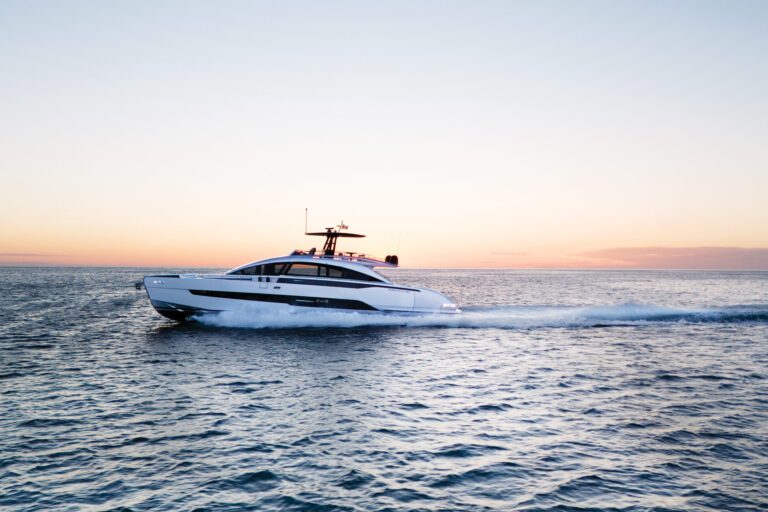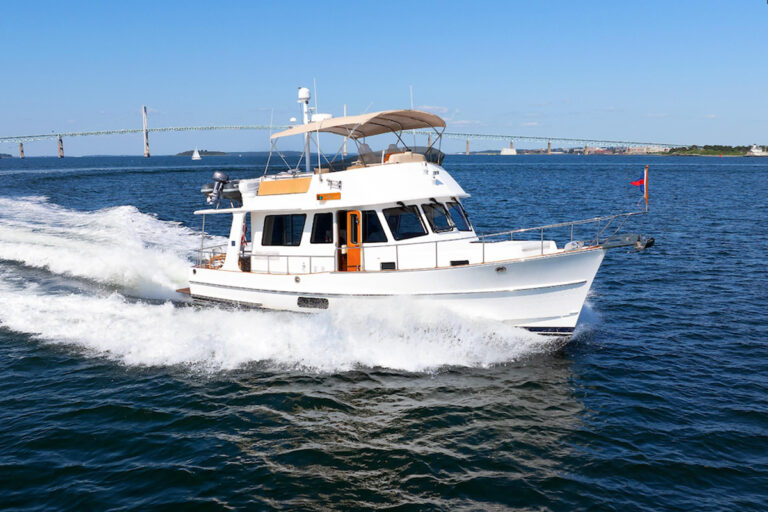If you’re cruising in Maine this summer, enter Hurricane Sound and look north. There you’ll see a boathouse with its gray shingles and white trim. You can’t miss the railway running up the eastern side of a rock outcropping. You’ll also notice a mooring ball with a strange vertical extension. This is Eben Gay’s guest mooring. It says so. His guests don’t have to lean over the bow to pick up a floating line or signet buoy. No, simply reach out with your boathook and lift the clean, dry pennant off the unusual Y-shaped plank.
You’re likely to see Eben up on the deck with his signature white beard and button-down shirt that matches his clear blue eyes. A nautical cap may protect his high forehead. Wave and say hello. He will probably invite you to pick up the guest mooring and chat a while. If you’re lucky, he’ll invite you in for a tour of his boathouse.
Though not a name recognized in worldwide ports of call, Ebenezer Gay is nonetheless a substantial figure among those who know him. Courtly and precise, Eben was curator of the Historical Scientific Instruments Museum at Harvard University for 20 years, where he learned the value of a-place-for-everything and everything-in-its-place.
In truth, Eben Gay would attract little attention in the yachting world if not for his boathouse. Situated at the northern end of Hurricane Sound on Vinalhaven, Maine, the boathouse is a masterpiece of Eben’s self-taught nautical engineering. Though not an engineer himself, his thoughts and ideas are anchored within a mind that searches for the best way to do something. He knows what’s needed.
Take that railway, for instance. Not every boathouse has one-at least, not one that scales a small El Capitan-but for Eben the truth was self-evident, even if geography wasn’t exactly cooperative. He had to haul his boat out.
Or take the boathouse itself. It is completely laid out so “everything can be done single-handedly,” and so nothing need be lifted by hand that’s more than 50 pounds in weight. Rest assured, there are reasons here.
But before we go into them, first a little background on Eben. His family is Old New England. He’s the namesake of ancestors who shaped this country and some of its religious tenets in the early 1700s. The first Ebenezer Gay, born in Dedham, Mass., in 1696, graduated from Harvard in 1714 and became the acknowledged founder of American Unitarianism. For 67 years he preached in the “Old Ship” church in Hingham, Mass.
Another of Eben’s early ancestors, Sydney, entered Harvard (Eben’s alma mater) at the age of 15, eventually becoming managing editor of the Chicago Tribune. And another ancestor, Winekworth, became a painter of landscapes and seascapes. One of his paintings was done for the Boston Athenaeum. Here old and new begin to merge, for it was at the Boston Athenaeum that our Eben became a librarian. It’s a small world.
Until World War II, life for Eben was relatively uncomplicated. A sniper’s bullet changed all that. Spinal tuberculosis followed, as did three years in a hospital. His “cure” left him with the ability to lift no more than 50 pounds of weight and a nautical knowledge gleaned from reading a vast number of books during his confinement.
It was in 1955 that he married Diana, known affectionately as “D.” Her mother owned the Vinalhaven property (sans boathouse), and “was a land-based person,” says Eben, “who wanted to move down the street” closer to town. Eben and D bought the site with its magnificent view of Hurricane Sound-one of America’s more famous cruising grounds. Side views of Long Cove and Leadbetter Narrows make for interesting boat watching during the summer months.
In 1968 the Gays decided to “get closer to the water.” They ordered a replica of a 25-foot Friendship sloop (with an 8-foot bowsprit) from Jarvis Newman, who recently had taken a fiberglass mold from a traditional wooden version. At the same time, Eben being Eben, he started designing the boathouse in which to store it for the winter. (The Gays close up the Vinalhaven house in fall and move to a shore-based condo in Rockland, Maine.)
This was not an easy engineering project, given Eben’s physical limitations and his desire for a single-handed facility. The building itself turned out to be 24 x 48 x 12 feet high with a railway up a steep grade from water to house. There could be no other way, for Eben.
So now he had to figure out how to transport the Jarvis Newman from the water to the top of the rock. “The whole concept,” says Eben, “was based on the fact that I wanted the steel-framed platform upon which the boat rests in its cradle to remain level as the boat was lowered or raised. I surely didn’t want it to tilt on the threshold of the boathouse and crash into the water below.”
This, in turn, required a powerful windlass to haul and lower the platform. But that led to the mast issue. Once up the rails, the mast had to be removed before entry into the house was possible. Here another ingenious Eben system was developed with the installation of a one-ton overhead bridge crane. This is used to unstep and eventually restep the mast. The crane is also used to offload the heavy boom (which is as long as the mast is tall) and other heavy gear. Remember the 50-pound limit.
Indoors, mast and boom are supported in brackets over the paint and varnish storage area. Each can be lowered for sanding and varnish work in the off season. Lines are also removed from the boat, washed, dried and coiled neatly, then hung by size along the north wall. Blocks are sanded and varnished with metal parts painted black. These too are hung by size along the north wall. Life jackets are brushed, covered with plastic and raised on a ceiling pulley system high above the floor (in order to discourage varmints from taking up winter residence).
Two items immediately elicit comment. The first is a chest Eben designed and built with 45 dovetail drawers, each itemized in handwritten italic. “I got involved with calligraphy years ago when I was a librarian at the Athenaeum. I found a copy of Arrigli’s First Manual of the Chancery Hand (1522) as translated by John Howard Benson, the sculptor, stone carver and calligrapher.” So, you see, even the writing in this boathouse is designed by Eben.
The second is a whalebone serving instrument Eben fashioned himself (naturally) from an ancient model he found in the cellar of the Peabody Museum. “It must have been carved by an old seaman,” he speculates. “Most people,” says Eben, “simply cut off the strand ends of an eye splice or burn them back. When you step on them in your bare feet you want to say Ônice’ things about the guy who made the splice. Sometimes, too, the ends tend to back out. Using this instrument I can wrap the splice with thread wound tight with about 700 pounds of pressure.”
Perhaps it isn’t necessary to add that Eben is a nautical knot nut. He teaches the art of tying to members of the local U.S. Power Squadron to which he belongs. Take a look at the knot at the end of the bell clapper. “Some people think it is a monkey’s fist,” says Eben. “It’s not. It’s a man rope knot.” Don’t think that the distinction is minor.
It was in 1971 that the Gays took delivery of the new Friendship sloop, named Diana. It was also the year that the boathouse was finished. It was, however, not the same boathouse envisioned in the original 1968 plans. “My mother, who had just been widowed, was with us for the summer,” says Eben. “When I showed her the boathouse plans she wanted to know if a small apartment could not be included. I had every square foot accounted for but in the end we managed a place for her.”
And what a place. It’s a four-room apartment with kitchen, bath, bedroom and living room looking out onto all of Hurricane Sound. A deck extends off to the east. This is used for many occasions, including an annual summer rendezvous of the Mid-Coast Sail & Power Squadron. “I have this old bell which I ring to call the assembled Squadron members to order.”
A wood stove is used to take the chill off the rooms in mother’s apartment. An ingenious pass-through wood hopper connects the living quarters with the wood storage area in the boathouse. And it’s also in the boathouse that two other boats winter with the Friendship sloop. One is a Peapod dory. “One of my dreams was to get my hands on a Peapod,” says Eben. When Peapod builder Ed Conklin sailed into Eben’s view aboard his Friendship Ray of Hope, Eben’s wishes came true.
The other boat is an early 1942 Dyer rowing skiff built on a Whitehall pattern. This 12-foot ancient pelican has received Eben’s TLC for years. Being Eben, he does things right: When the Dyer or the Peapod wants a new oar, he cuts down a tree and fashions it from scratch.
A boathouse with its own railroad, one-ton crane and a mother’s apartment may not cause the world to beat a path to Eben Gay’s mooring. But if you’re cruising in Hurricane Sound anytime soon, you may want to keep your eyes peeled for the white-bearded man in the nautical cap. If you’re lucky, you may get invited for the tour. It will be worth it.
All aboard!





